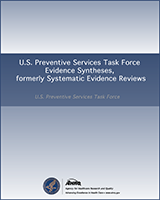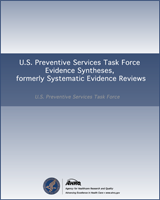NCBI Bookshelf. A service of the National Library of Medicine, National Institutes of Health.
This publication is provided for historical reference only and the information may be out of date.
Structured Abstract
Context:
Dyslipidemias, disorders of lipid metabolism, are important risk factors for coronary heart disease (CHD). Identification of children with dyslipidemias could lead to interventions aimed at decreasing their risk of CHD as adults.
Objective:
To determine the strengths and limits of evidence about the effectiveness of selecting, testing, and managing children and adolescents with dyslipidemia in the course of routine primary care. Screening children and adolescents has the potential to identify three groups with dyslipidemia: those with 1) undiagnosed monogenic dyslipidemia, 2) undiagnosed secondary dyslipidemia, and 3) idiopathic dyslipidemia (polygenic, risk factor associated, or multifactorial). Key questions examined a chain of evidence about the accuracy and feasibility of screening children in various settings, tracking of lipid levels through childhood to adulthood, role of risk factors in selecting children for screening, effectiveness of interventions for children identified with dyslipidemia, and adverse effects of screening and interventions.
Data Sources:
Relevant studies were identified from multiple searches of MEDLINE, PsychInfo, the Cochrane database of systematic reviews and controlled clinical trials, and EMBASE (1966 to September 2005). Additional articles were obtained from recent systematic reviews, reference lists of pertinent studies, reviews, editorials, and websites, and by consulting experts.
Study Selection:
Eligible studies were applicable to U.S. clinical practice, available in English, and provided primary data relevant to key questions. Cohort studies were used for assessment of risk factors. Comparative and non-comparative prospective studies of screening for dyslipidemia in children provided information on the efficacy of these programs and the accuracy of screening with family history information. Randomized, non-randomized and non-comparative studies were used for assessment of risk factors. Only randomized controlled trials were considered for examining the effectiveness of interventions. Studies of children with previously diagnosed monogenic dyslipidemia were considered for the evaluation of treatment because those are the only children in whom some drugs have been tested.
Data Extraction:
Data were extracted from each study and entered into evidence tables.
Data Synthesis:
Studies were summarized by descriptive methods and rated for quality using criteria developed by the U.S. Preventive Services Task Force (USPSTF). Normal values for lipids for children and adolescents are currently defined according to population levels (percentiles). More recent studies indicate age, sex, and racial differences and temporal trends that shift cut points. Tracking of lipid levels through childhood is strongest for TC and LDL. Approximately 40–55% of children with elevated total cholesterol (TC) and low-density lipoprotein (LDL) defined by percentile will continue to have elevated lipids on follow-up. Current screening recommendations based on family history will fail to detect substantial numbers (30–60%) of children with elevated lipids. Evidence from epidemiologic studies establish a strong statistical association between overweight and elevations in lipids whereas other risk factors (diet, physical inactivity, aerobic capacity/fitness, puberty level and smoking) have not been adequately assessed. Currently recommended screening strategies have limited diagnostic accuracy, low adherence to guidelines by providers, and limited compliance by parents and children. No trials compare strategies of screening in children. Parental non-compliance with screening and follow-up recommendations is reported.
Drug treatment for dyslipidemia in children has been studied only in children with familial monogenic dyslipidemias (familial hypercholesterolemia [FH] or familial combined hyperlipidemia [FCH]). In this population, 9 randomized controlled trials demonstrate the effectiveness of statins for reducing TC and LDL (% mean reduction from meta-analysis of trials: 24.4%[95% CI 19.5, 29.2] for TC, 30.8% [95% CI 24.1, 37.5] for LDL, 8 studies). Two fair quality trials showed benefit from bile acid binding resins. Randomized controlled trials of diet supplements (psyllium, oat, garlic extract, and sterol margarine) and advice showed marginal improvements in lipids in children with monogenic dyslipidemia. For children without monogenic dyslipidemia, a good quality study showed that high intensity counseling is effective in reducing TC and LDL levels while the intervention is sustained, but not after it ceases. Other studies of diet advice showed no or minimal improvement. Dietary fiber supplements had mixed results in two trials in children and adolescents without monogenic dyslipidemia, and one oat bran supplement trial showed no effect. Six trials of exercise demonstrated little or no improvements in lipids for children without monogenic dyslipidemia (% mean reduction from meta-analysis of trials: 0% [-5.6, 5.6] for TC, 3.1% [-7.7, 1.5] for LDL, 4 studies).
Eighty-one controlled and non-controlled studies of treatment reported a variety of adverse effects of drug, diet, exercise, and combination therapy in children and adolescents. There are reports of growth retardation and nutritional dwarfing in children and adolescents for whom formal dietary assessment and advice was delayed. Although reported adverse effects were not serious, studies were generally small and not of sufficient duration to determine long-term effects of either short or extended use.
Conclusions:
Normal values for lipids for children and adolescents are currently defined according to population levels (percentiles). Tracking of lipid levels in children is variable, although evidence is stronger for TC and LDL than for HDL and TG. Screening using family history misses substantial numbers of children with elevated lipids. Most trials of drug interventions demonstrate improvement, but these trials were performed in selected groups of children. Several key questions could not be addressed because of lack of studies, including the effectiveness of screening on adult CHD or lipid outcomes, optimal ages and intervals for screening children, cost-effectiveness of screening, or the effects of treatment of lipids in childhood on adult CHD outcomes.
Keywords:
Dyslipidemia; Children; Screening.
Contents
- Acknowledgments
- 1. Introduction
- 2. Methods
- 3. Results
- Key Question 1. Is Screening for Dyslipidemia in Children/adolescents Effective in Delaying the Onset and Reducing the Incidence of CHD-related Events?
- Key Question 2. What is the Accuracy of Screening for Dyslipidemia in Identifying Children/adolescents at Increased Risk of CHD-related Events and Other Outcomes?
- Key Question 2a. What are Abnormal Lipid Values in Children/adolescents?
- Key Question 2b. What are the Appropriate Tests? How Well do Screening Tests (Non-fasting Total Cholesterol, Fasting Total Cholesterol, Fasting Lipoprotein Analysis) Identify Individuals with Dyslipidemia?
- Key Question 2c. How Well do Lipid Levels Track from Childhood to Adulthood?
- Key Question 2d. What is the Accuracy of Family History in Determining Risk?
- Key Question 2e. What are Other Important Risk Factors?
- Key Question 2f. What are Effective Screening Strategies for Children/adolescents (Including Frequency of Testing, Optimal Age for Testing)?
- Key Question 3. What are the Adverse Effects of Screening (Including False Positives, False Negatives, Labeling)?
- Key Question 4. In Children/adolescents, What is the Effectiveness of Drug, Diet, Exercise, and Combination Therapy in Reducing the Incidence of Adult Dyslipidemia, and Delaying the Onset and Reducing the Incidence of CHD-related Events (Including Optimal Age for Initiation of Treatment)?
- Key Questions 5 – 8. What is the Effectiveness of Drug, Diet, Exercise, and Combination Therapy for Treating Dyslipidemia in Children/adolescents?
- Key Question 9. What are the Adverse Effects of Drug, Diet, Exercise, and Combination Therapy in Children/adolescents?
- Key Question 10. Does Improving Dyslipidemia in Childhood Reduce the Risk of Dyslipidemia in Adulthood?
- Key Question 11. What are the Cost Issues Involved in Screening for Dyslipidemia in Children/adolescents?
- 4. Discussion
- 5. Evidence Tables
- Appendixes
- Appendix 1. Abbreviations
- Appendix 2. Units of Measure Conversion Formulas
- Appendix 3. Search Strategies for Child and Adolescent Dyslipidemia
- Appendix 4. Inclusion/Exclusion Criteria and Results of Searches
- Appendix 5. U.S. Preventive Services Task Force Quality Rating Criteria
- Appendix 6. Statistical Methods Used for Meta Analysis
- References
This report is based on research conducted by the Oregon Evidence-based Practice Center (EPC), Portland, Oregon under contract to the Agency for Healthcare Research and Quality (AHRQ)1 , Rockville, MD (Contract No. 290-02-0024, Task Order Number 1).
The findings and conclusions in this document are those of the authors, who are responsible for its content, and do not necessarily represent the views of AHRQ. No statement in this report should be construed as an official position of AHRQ or of the U.S. Department of Health and Human Services.
The information in this report is intended to help clinicians, employers, policymakers, and others make informed decisions about the provision of health care services. This report is intended as a reference and not as a substitute for clinical judgment.
This report may be used, in whole or in part, as the basis for the development of clinical practice guidelines and other quality enhancement tools, or as a basis for reimbursement and coverage policies. AHRQ or U.S. Department of Health and Human Services endorsement of such derivative products may not be stated or implied.
- 1
540 Gaither Road, Rockville, MD 20850. www
.ahrq.gov
- Review Lipid Screening in Childhood for Detection of Multifactorial Dyslipidemia: A Systematic Evidence Review for the U.S. Preventive Services Task Force[ 2016]Review Lipid Screening in Childhood for Detection of Multifactorial Dyslipidemia: A Systematic Evidence Review for the U.S. Preventive Services Task ForceLozano P, Henrikson NB, Morrison CC, Dunn J, Nguyen M, Blasi P, Whitlock EP. 2016 Aug
- Review Lipid Screening in Childhood and Adolescence for Detection of Familial Hypercholesterolemia: A Systematic Evidence Review for the U.S. Preventive Services Task Force[ 2016]Review Lipid Screening in Childhood and Adolescence for Detection of Familial Hypercholesterolemia: A Systematic Evidence Review for the U.S. Preventive Services Task ForceLozano P, Henrikson NB, Dunn J, Morrison CC, Nguyen M, Blasi PR, Anderson ML, Whitlock E. 2016 Aug
- Review Behavioral Counseling to Promote a Healthful Diet and Physical Activity for Cardiovascular Disease Prevention in Adults Without Known Cardiovascular Disease Risk Factors: Updated Systematic Review for the U.S. Preventive Services Task Force[ 2017]Review Behavioral Counseling to Promote a Healthful Diet and Physical Activity for Cardiovascular Disease Prevention in Adults Without Known Cardiovascular Disease Risk Factors: Updated Systematic Review for the U.S. Preventive Services Task ForcePatnode CD, Evans CV, Senger CA, Redmond N, Lin JS. 2017 Jul
- Review Screening and Interventions for Childhood Overweight[ 2005]Review Screening and Interventions for Childhood OverweightWhitlock EP, Williams SB, Gold R, Smith P, Shipman S. 2005 Jul
- Review Screening and treatment for lipid disorders in children and adolescents: systematic evidence review for the US Preventive Services Task Force.[Pediatrics. 2007]Review Screening and treatment for lipid disorders in children and adolescents: systematic evidence review for the US Preventive Services Task Force.Haney EM, Huffman LH, Bougatsos C, Freeman M, Steiner RD, Nelson HD. Pediatrics. 2007 Jul; 120(1):e189-214.
- Screening for Lipid Disorders in Children and AdolescentsScreening for Lipid Disorders in Children and Adolescents
Your browsing activity is empty.
Activity recording is turned off.
See more...

